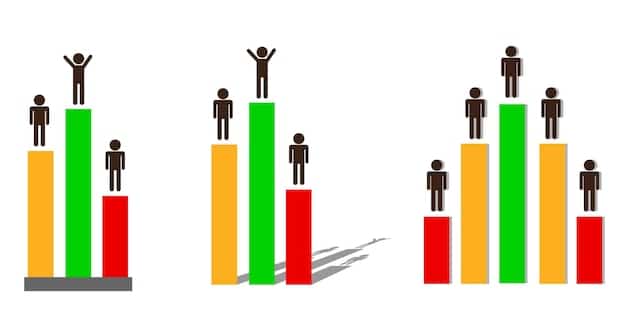Unveiling the Significance of the 2025 NAEP Results

The Significance of the 2025 National Assessment of Educational Progress (NAEP) Results lies in providing a comprehensive snapshot of student academic performance across the United States, highlighting trends, achievement gaps, and areas needing improvement in the education system.
The release of the Significance of the 2025 National Assessment of Educational Progress (NAEP) Results is a pivotal moment for educators, policymakers, and parents alike, offering a comprehensive view of student achievement across the nation.
Understanding the NAEP: A National Yardstick
The National Assessment of Educational Progress (NAEP), often referred to as “The Nation’s Report Card,” serves as a vital tool for gauging the academic performance of students in the United States. Its consistent and standardized assessment provides a unique lens through which to view educational trends and outcomes.
What is NAEP?
NAEP is a nationally representative and continuing assessment of what students in the United States know and can do in various subjects. It is administered by the National Center for Education Statistics (NCES), part of the U.S. Department of Education.
Why is NAEP Important?
NAEP’s significance stems from its ability to provide reliable and comparable data across states and over time. This allows policymakers and educators to make informed decisions about curriculum development, resource allocation, and educational reforms.

Understanding its role and function is crucial for interpreting the **Significance of the 2025 National Assessment of Educational Progress (NAEP) Results** effectively.
The Scope of the 2025 NAEP
The 2025 NAEP will cover a range of subjects and grade levels, providing a broad overview of student performance. The specific subjects and grades assessed can vary from year to year, but core subjects like math and reading are consistently included.
- Reading Assessments: Assessing reading comprehension and literacy skills.
- Mathematics Assessments: Evaluating mathematical knowledge and problem-solving abilities.
- Science Assessments: Measuring understanding of scientific concepts and principles.
- Writing Assessments: Assessing written communication skills and composition abilities.
The 2025 NAEP administration will involve standardized testing procedures to ensure consistency and comparability across different schools and districts.
Key Areas Highlighted by NAEP Results
NAEP results shed light on several critical areas within the education system, including achievement gaps, trends in student performance, and the effectiveness of educational policies. These insights are valuable for guiding targeted interventions and improvements.
Achievement gaps often become apparent through NAEP data, revealing disparities in performance among different student subgroups, such as racial and ethnic minorities, low-income students, and students with disabilities.

Understanding these gaps is essential for promoting equity and ensuring that all students have access to high-quality education.
Interpreting the 2025 NAEP Data
Interpreting NAEP data requires careful consideration of various factors, including assessment frameworks, scoring methodologies, and contextual influences. The data is typically presented in the form of average scores and achievement levels.
Average scores provide an overall measure of student performance in a given subject. Achievement levels, such as Basic, Proficient, and Advanced, indicate the degree to which students have mastered the content covered in the assessment.
It’s important to compare the Significance of the 2025 National Assessment of Educational Progress (NAEP) Results with previous years to identify trends and assess whether student performance is improving, declining, or remaining stable.
Using NAEP Results for Educational Improvement
NAEP isn’t just about reporting; it’s a crucial tool for driving improvements in education. By identifying areas where students struggle, educators and policymakers can target interventions and resources more effectively.
Curriculum Development
NAEP results can inform curriculum development by highlighting areas where students may need additional instruction or support. Educators can use this information to tailor their teaching methods and materials to better meet the needs of their students.
Policy Decisions
Policymakers can use NAEP data to evaluate the effectiveness of different educational policies and programs. This information can help them make informed decisions about resource allocation and policy reforms.
The Significance of the 2025 National Assessment of Educational Progress (NAEP) Results is most realized when the data is carefully analyzed and used to inform practical changes in classrooms and at the policy level.
Impact of NAEP on Local Education Agencies
Local Education Agencies (LEAs), including school districts and individual schools, play a critical role in utilizing NAEP results to improve educational outcomes at the local level. Understanding their impact and responsibilities is of major importance.
- Data Analysis: LEAs can conduct in-depth analyses of NAEP results to identify specific strengths and weaknesses within their schools and districts.
- Targeted Interventions: Based on NAEP findings, LEAs can implement targeted interventions to address areas where students are struggling.
- Professional Development: NAEP data can inform professional development programs for teachers, providing them with insights into effective instructional strategies.
By engaging actively with the **Significance of the 2025 National Assessment of Educational Progress (NAEP) Results**, LEAs can make meaningful improvements in student achievement.
| Key Point | Brief Description |
|---|---|
| 📊 Achievement Gaps | Highlights disparities among student groups. |
| 📈 Performance Trends | Tracks student progress over time. |
| 🍎 Curriculum Impact | Informs improvements to teaching strategies. |
| 🏛️ Policy Guidance | Guides decisions about resource allocation. |
Frequently Asked Questions (FAQ)
▼
NAEP’s main goal is to provide a comprehensive assessment of student knowledge and skills in various subjects across the United States, offering data to improve educational practices.
▼
NAEP is administered periodically, with different subjects assessed on a rotating schedule, typically every two to four years, depending on the subject area.
▼
NAEP involves a representative sample of students from public and private schools across the country to ensure results reflect the national student population.
▼
Schools use NAEP results to evaluate their curriculum, identify areas for improvement, and tailor their teaching methods to better meet student learning needs.
▼
You can find the complete NAEP results and related reports on the National Center for Education Statistics (NCES) website, a part of the U.S. Department of Education.
Conclusion
The **Significance of the 2025 National Assessment of Educational Progress (NAEP) Results** extends far beyond mere numbers. It provides a critical lens through which to examine the strengths and weaknesses of the US education system, guiding policy, curriculum, and instructional practices towards the goal of improved educational outcomes for all students.





